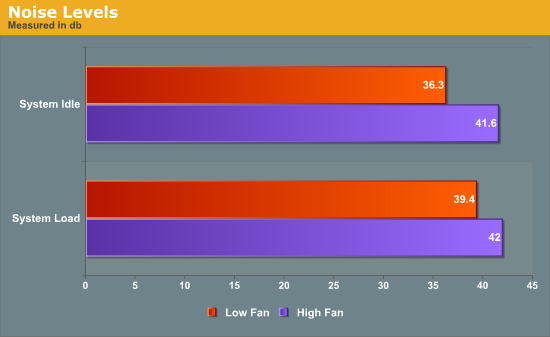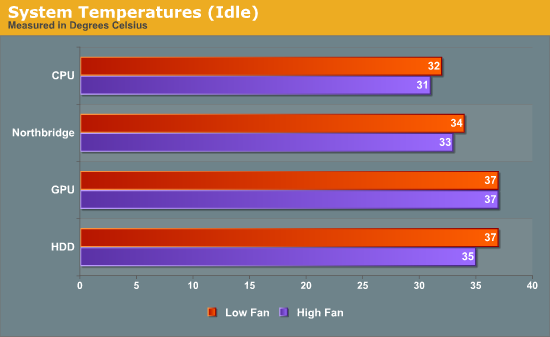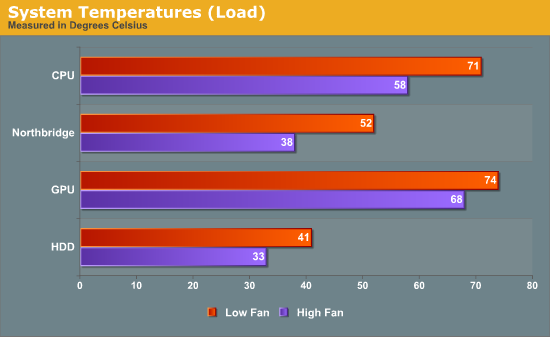SilverStone GD04 HTPC Case: Cool, Not Quiet
by Dustin Sklavos on December 25, 2010 12:00 AM EST- Posted in
- Cases/Cooling/PSUs
- HTPC
- SilverStone
- GD04
Thermal and Noise Testing
In testing the SilverStone GD04, I actually added components you're not going to see in the gallery but wound up needing just to keep the noise level down: the Zalman CNPS7000, which with the included FanMate controller was kept running at a low setting, and a Xigmatek Mono-Cool fan controller, the only controller I could find on NewEgg that fit into an expansion slot instead of a drive bay. The Xigmatek controller has headers for three fans, making it seem perfectly tailored to this task. Noise was measured using an Extech SL10 sound meter, while temperatures were measured conventionally using HWMonitor. The test system specs are as follows:
| Test Configuration | |
| CPU | AMD Athlon II X4 640 |
| Motherboard | ASUS M4A78LT-M AM3 MicroATX |
| Graphics Card | EVGA GeForce GTS 450 |
| Memory | 2x2GB DDR3-1333 |
| Drives |
LG HD-DVD/Blu-ray/DVDRW Combo Drive 1x Western Digital Caviar Blue 640GB |
| CPU Cooler | Zalman CNPS7000 |
| Power Supply | PC Power & Cooling 500W |
These aren't loud components to begin with, but remember: this is a media center case with three 120mm fans, and at least in my apartment it's going to be out in the open. Silence is paramount for a build like this. To generate load temperatures and noise, I ran 3DMark06 in a loop with Prime95 in the background and left it running for fifteen minutes at a time. The system was tested with the fan controller at its lowest and highest settings, and the sound meter was positioned one foot away from the tower, on a tripod, pointed directly at the side of the case.

While the fan noise wouldn't be a major issue for a normal PC that's probably going to be hidden under or near a desk, a media center PC really does need to run quieter than this. The first time I powered it up I was actually alarmed at how loud it was, and even though the character of the noise is a low whooshing, it's nonetheless very audible. Not good. So how are the thermals, then?


Thermals are actually pretty decent; remember this is a heavy artificial load being placed on the system. With the fans running at full bore everything's actually pretty good, but at low speed the processor's temperature becomes a bit worrying. Odds are good in actual use the CPU won't get this hot, but it's still not ideal. The idle temperatures are excellent at least.










68 Comments
View All Comments
tno - Monday, December 27, 2010 - link
I'm gonna second your suggestions. There seems to be a lot of emotion flying around and I think that's great. I love that everyone here is so passionate about these things. And I've been in your spot in the past RobertR, and about Jarred (my apologies), who is clearly good enough, my complaints not withstanding, to warrant a supervisory position. So let's take all this in perspective.RobertR, they get it, you don't like the job they did. If you would like acknowledgment, then consider all the replies you've received all the acknowledgment you should reasonable need.
McKish, perhaps shooting Dustin an e-mail with a review of his review would help in future articles.
Jarred, Dustin might not have the hardware resources that AT does, but he does have the hivemind. Perhaps the next article should get a preview in the case section of the forum. Before I chose my case (P150) I scoured the old articles and soon after turned to the forums and found so much information that my choice was made easy and once bought all the information I needed to pick the right sound components for the case. That said, it's easy for a comment or paragraph to spark all sorts of reactions (see everything in these comments for proof) but once you've gotten through all the nonsense, there's often some good points to be made.
So keep on going Dustin. Your writing is great, and your methods will get there. For a look at good methods and iffy writing, see anything on silentpcreview.com that isn't written by Mike Chin. Find something between there methods and yours and you'll have it all together. And keep up the case reviews; to get you going, start posting on all the forums you can find, get involved in the online community that obsesses over this stuff, and get your name known by the community reps that control the equipment. My favorite part of your review, realistic components. And yes, they are realistic, most people putting together an HTPC just put together a quicky job that will do the work. They don't obsess over every single component to find the coolest running, quietest component possible. Indeed, most probably take spare parts they have lying around. SPCR's habit of using outdated overkill components with silent cooling components is above and beyond what any of us would roll. I would definitely recommend having on hand whatever the "BEST" component for the category your testing per AT. For instance the quieter ATI cards seem to be a favorite for HTPC's on AT, perhaps having one of those available would quiet the beasts.
Alright, that's my wall of text. Flame on!
tno
khaakon - Sunday, December 26, 2010 - link
Is it only me, or have I missed any comments about this case short depth? It is very few HTPC cases with this form factor and it really makes a difference when you're putting the box in place and fitting all the goddam cables ;)Anymore depth in the approach when testing wouldn't be amiss also, (environment and adaption) but nice try anyway - just no spliff.. I mean Cigar.. for Dustin.
juzz86 - Monday, December 27, 2010 - link
I would just like to say that it's been a while since I've seen a case review here, and I love them. Let's see a few more!marc1000 - Monday, December 27, 2010 - link
it's good to see a review of a case that works with positive air pressure.ignoring all the flames about noise, the temperature of components seemed pretty good. they show a big difference regarding slow/fast fan RPM, yet even on lowest speed it seems very cool to me. I would like to ask that positive air pressure is tested on other cases (it could be a quick test, just to compare with the default configuration, and done simply reversing any output fans to make then intake ones - except GPU/PSU of course).
thanks for the review,
combust3r - Monday, December 27, 2010 - link
I belive that Dustin mentioning possible collision with left 120mm fan and long PSU's is a valuable info for those who want to use this case as a gaming rig. I bought Grandia GD05 for my Sandy Bridge build and I've already ordered GTX 460 wich is relatively short comparing to many high end 10.5"/11" cards that this case supports. My Seasonic M12II 520W will fit with no problems at all but PSU's longer than 180mm will force you to replace 120mm with 80mm fan (left fan mounts are predrilled for 80mm fan). Airflow (as seen in the review) is very good and it's worthy to mention that graphic cards with external exhausts are preffered.Regarding db measurement, if this is standard procedure in noise testing in all anandtech case reviews then I'm fine with it. They must be comparable.
I really like your review Dustin, keep up the good work.
orenlevy - Monday, December 27, 2010 - link
there is a simple way to reach silence in those areas1 you need mobo with 2 or 3 headers that u can control threw software
planty of those mobo are there(u can Google it to find)
2 find the right fan configure mostly to make a side to side air flow in the case
normally you should covers the places where air can go in the other sides.
3 make rules in speedfan give minimum and maximum speeds of the fans.
discover what are the temperature u reading and start to make the logic
if CPU then fan n01 will ramp and so on
one fan normally on the hard drive so it will controlled also buy hard-drive temp
after a bit of experience today it takes me no more then 5 min.
the fans actually can rest in idle and small surfing playing music and in a bit of stress the fans gos around 600 rpm in full 1000 rpm then it is important choose the wright power supply
,the only thing u can hear
ClagMaster - Monday, December 27, 2010 - link
I am surprised no mention was made of the fans that came with the case. Who made the fans and what are their rated speed, air flow and noise.I never had a complaint about a Silverstone case. These are well made though a little on the pricey side.
I would have invested in three 120mm Synthe Fans with the same air flow instead of the fan controllers. Its ridiculous to have two fan controllers in a HTPC.
combust3r - Wednesday, December 29, 2010 - link
http://www.globefan.com/products_detail.php?Pid=23...These are the fans used.
The middle one in the chart, RL4ZS1202512LIW-3M 12V DC 0.26A
34dBA, 2K rpm...
ClagMaster - Wednesday, December 29, 2010 - link
Thank youClagMaster - Wednesday, December 29, 2010 - link
These fans are rated at 93 cfm each !!! And there are 3 of these !!!This is way, way too much for a home entertainment center.
I would have replaced these with Scythe SY1225SL12M 120mm "Slipstream" Case Fan
1200 RPM, 68 cfm, 24 dBA
And there would still be plenty of air flow
Again, thanks for answering my question.